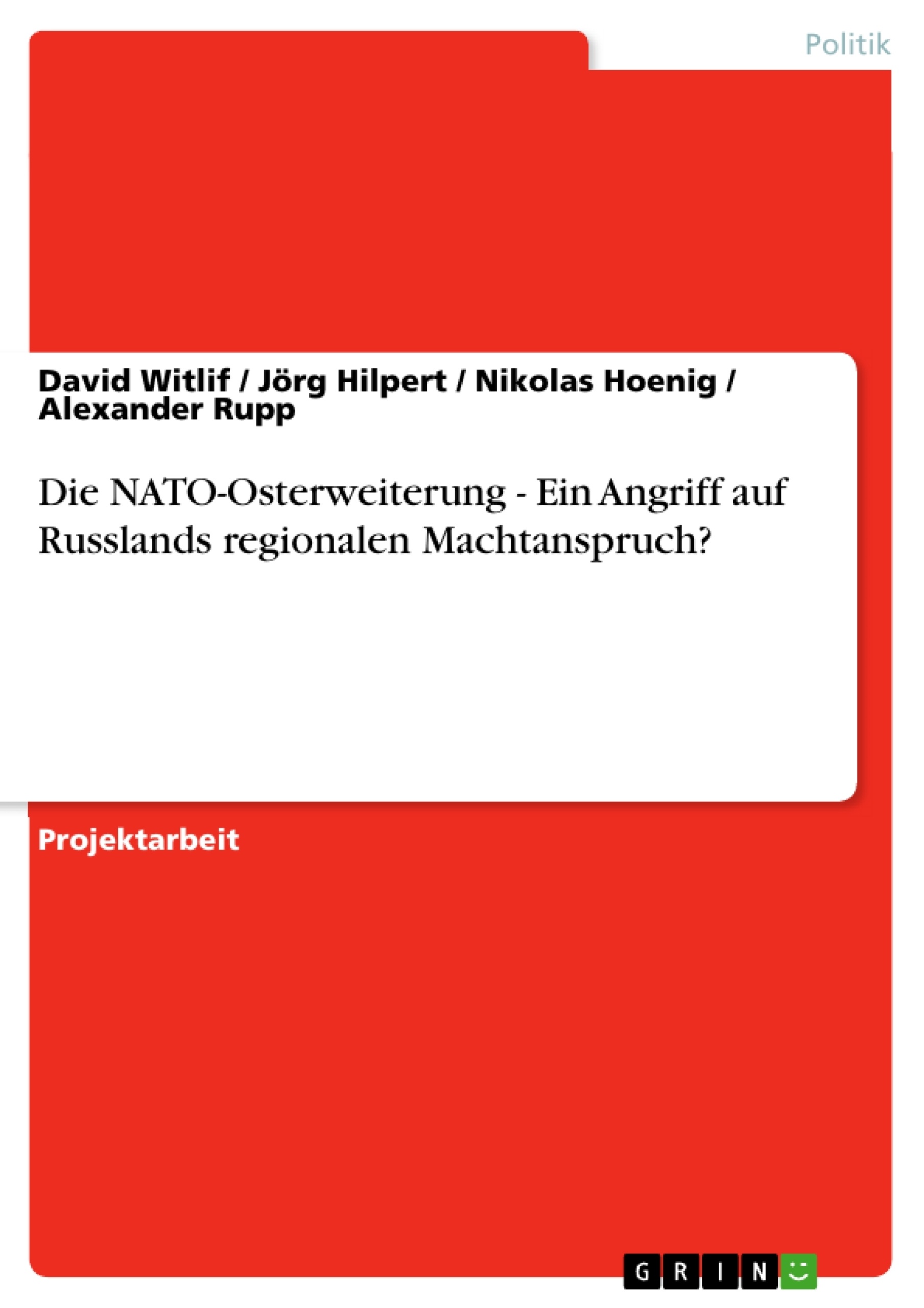Die Arbeit bietet eine qualitative Dokumentenanalyse zur Frage, ob die NATO-Osterweiterung Russlands Machtanspruch eingeschränkt hat. Dabei sollen deutsche und russische Zeitungs- und Zeitschriftenartikel sowie offizielle Statements aus der Amtszeit Jelzins (1991 – 1999) und Putins (2000 – 2008) anhand eines erarbeiteten Codesystem analysiert werden, wobei für die Analyse das
Auswertungstool MAXQDA verwendet wird.
Zu Beginn soll kurz der aktuelle Forschungsstand wiedergegeben werden, auf dem
anschließend das erarbeitete theoretische Konzept aufbaut. Zudem erfolgt eine
Definition der Region sowie des Machtkonzeptes, welches für die spätere Analyse relevant ist.
This paper offers a qualitative analysis of documents on the question of whether
NATO's eastward expansion has restricted Russia's power. Therefore German and
Russian newspaper and magazine articles and official statements from Yeltsin's
(1991 - 1999) and Putin’s (2000 - 2008) mandate will be analyzed by using a developed
code system and the analysis tool MAXQDA.
At the beginning the current status of research will be summarized briefly. Afterwards
the theory concept will be presented. In addition, a definition of the region
and the concept of power, which are relevant for the subsequent analysis will be
given.
Inhaltsverzeichnis
- 1 Einleitung
- 2 Historischer Abriss
- 2.1 UdSSR/ Russland
- 2.2 NATO
- 2.3 Die Osterweiterung der NATO
- 3 Aktueller Forschungsstand
- 4 Theoretischer Hintergrund
- 4.1 Überblick
- 4.2 Theorieansätze
- 4.2.1 Realismus
- 4.2.2 Struktureller Ansatz
- 4.2.3 Nye: Hard-, Soft- und Smart-Power
- 4.3 Anpassung des Konzeptes von Barnett & Duvall und Nye
- 5 Abgrenzung der Region
- 6 Methodik
- 6.1 Qualitative Sozialforschung
- 6.1.1 Begründung für eine qualitative Herangehensweise
- 6.1.2 Merkmale qualitativer Forschung
- 6.2 Theorie der qualitativen Sozialforschung
- 6.2.1 Symbolischer Interaktionismus (SI)
- 6.2.2 Phänomenologie
- 6.2.3 Schnittmengen der Ansätze
- 6.3 Untersuchungsdesign: Dokumentenanalyse
- 6.4 Untersuchungsmethoden: (Zusammenfassende) qualitative Inhaltsanalyse
- 6.5 Quantitative- vs. qualitative Sozialforschung
- 6.6 Gütekriterien qualitativer Sozialforschung
- 6.7 Auswertung mittels MAXQDA
- 6.7.1 Kategoriensystem
- 6.7.2 Codieren
- 6.7.3 Code-Häufigkeit
- 6.7.4 Intercoderreliabilität und Textzusammenfügung
- 6.7.5 Codeplan
- 6.7.5.1 Erläuterungen zum Codeplan
- 6.1 Qualitative Sozialforschung
- 7 Auswertung/ Analyse
- 8 Ergebnis
- 9 Fazit Ausblick
- 10 Kritik
Zielsetzung und Themenschwerpunkte
Die Arbeit untersucht mittels qualitativer Dokumentenanalyse den Einfluss der NATO-Osterweiterung auf Russlands Machtanspruch. Die Analyse basiert auf deutschen und russischen Zeitungsartikeln, Zeitschriftenartikeln und offiziellen Statements aus den Amtszeiten Jelzins und Putins. Es werden theoretische Konzepte des Realismus, des strukturellen Ansatzes und Nyes Hard-, Soft- und Smart-Power Konzepten herangezogen und angepasst.
- Historische Entwicklung der Beziehungen zwischen Russland/UdSSR und der NATO
- Theoretische Einordnung des Machtkonzepts und der regionalen Abgrenzung
- Methodische Vorgehensweise der qualitativen Dokumentenanalyse
- Analyse der russischen und westlichen Reaktionen auf die NATO-Osterweiterung
- Bewertung der NATO-Osterweiterung als Angriff auf Russlands Machtanspruch
Zusammenfassung der Kapitel
Kapitel 1 bildet eine Einleitung in das Thema. Kapitel 2 bietet einen historischen Abriss der UdSSR/Russlands und der NATO, inklusive der NATO-Osterweiterung. Kapitel 3 fasst den aktuellen Forschungsstand zusammen. Kapitel 4 erläutert den theoretischen Hintergrund, inklusive der Anpassung von Konzepten von Barnett & Duvall und Nye. Kapitel 5 grenzt die betrachtete Region ab. Kapitel 6 beschreibt die Methodik der qualitativen Dokumentenanalyse, einschließlich der verwendeten Software MAXQDA.
Schlüsselwörter
NATO-Osterweiterung, Russland, Machtanspruch, Qualitative Dokumentenanalyse, Realismus, Struktureller Ansatz, Soft Power, Hard Power, Smart Power, Jelzin, Putin, MAXQDA.
- Quote paper
- David Witlif (Author), Jörg Hilpert (Author), Nikolas Hoenig (Author), Alexander Rupp (Author), 2008, Die NATO-Osterweiterung - Ein Angriff auf Russlands regionalen Machtanspruch?, Munich, GRIN Verlag, https://www.hausarbeiten.de/document/121458


